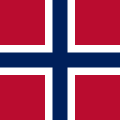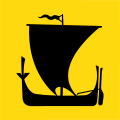Flag of norway
| Flag of norway | |
|---|---|
 |
|
| Vexillological symbol : |
|
| Aspect ratio: | 8:11 |
| Officially accepted: | July 17, 1821 |
The flag of Norway shows a dark blue so-called Scandinavian cross with a white outline on a red background, shifted to the flagpole .
symbolism
The Norwegian flag comes only partially from the colors of the royal family. Rather, it is based on the Danish flag , with a red background and a white cross. From 1537 to 1814 Norway was legally a Danish province, although this rule by Christian III. was never fully implemented. The blue cross comes from the Swedish flag from the time of the union with Sweden.
16:27 ? Structure of the state and maritime flag

history
Since the 16th century, because of the union with Denmark , Norway used the Danish flag, the so-called Dannebrog . During the temporary independence in 1814, the Norwegian King Christian Frederik added the Norwegian national coat of arms , the lion with a curved halberd, to the Danish flag in the upper leech . This flag was used until 1821. The war flag also had a swallowtail. This flag was used until 1815.
In the autumn of 1814 Norway was forced into a personal union with Sweden . In the revised November constitution it was determined that Norway could have its own trade flag. The war flag had to be a Union flag. From 1815 it was the Swedish flag with a white St. Andrew's cross on a red upper leech. The Dannebrog with the lion in the upper Liek was not recognized by the pirate states in the Mediterranean. Ships flagged in this way were hijacked. So it could only be led north of Cape Finisterre . A Union flag with a white St. Andrew's cross on a red background in the upper leech was introduced in 1818 for trips to the Mediterranean.
This was followed by the time known as “flaggforvirrings år” (the year of flag confusion), because several flags were allowed side by side, depending on the water in which the ship was located. In 1821 there was a new initiative for its own flag with many designs. Fredrik Meltzer , Member of the Norwegian Parliament ( Storting ) , designed the flag that is in use today (the "pure tricolor"). It was allowed to be used in the North Sea from 1821. Norwegian ships could use the Swedish or Union flag for Mediterranean voyages, while the Dannebrog with lion, the Swedish trade flag, the Union flag and the “pure tricolor” were permitted on the North Sea and the North Atlantic.
From 1844, King Oskar I also displayed a combination of both national flags in the upper Liek of both the Norwegian and the Swedish flag as a symbol of the equality of the two states of the Union. This flag replaced all other trade flags. Norway also received its own war flag with the new Union field in the upper liek. As Gösch was a small flag, which used only consisted of the Union field. These flags were initially welcomed in Norway because they officially showed the equality of states. But soon resistance, as in Sweden and it was derogatory Sillsallad herring salad called. Therefore, Norwegian ships only used this flag when seeking consular protection abroad. Otherwise they left out the union field and only hoisted the "pure tricolor". King Oskar also introduced a new royal flag for the first time: the war flag of the Union coat of arms on the center of the cross. After 1905 the previous royal flag was replaced by a flag with a golden lion with an ax on a red cloth.
Growing opposition to the Union ensured that the Norwegian Parliament decided in 1898 to introduce Meltzer's "pure flag" as a commercial and national flag on January 1, 1899, and to use the same design for the state flag, customs flag and postal flag. The Union symbol was banned from the Norwegian war flag on June 9, 1905, immediately after the dissolution of the Union (from its Swedish counterpart, however, not until the end of 1905).
 ? Norway, 1814 to 1821
? Norway, 1814 to 1821
16:27 ? Union Flag (War Flag), 1815 to 1844



 ? Union Flag (Trade Flag), 1818 to 1844
? Union Flag (Trade Flag), 1818 to 1844
16:27 ? Union Flag (War Flag), 1844-1905


Royal flags
King Haakon VII introduced the royal standard in 1905, which has remained unchanged since then. It shows the Norwegian lion in a different form compared to the Norwegian national coat of arms . The standard of the Crown Prince has a dovetail.
Military flags
The war flag on land and at sea corresponds to the national flag of Norway. The navy jack is a square variant of the national flag. The state and war flags are also flown by merchant ships and ferries, the captain of which is a reserve officer .
16:27 ? State and war flag

The lion on the flags of the Defense Minister and the Commander-in-Chief correspond to that on the national coat of arms of Norway. When this was stylized on the coat of arms in 1937, the same thing happened with the lions on the flags.
The command signals of the flag officers have remained unchanged since 1905.
Subnational flags
Norway is divided into eleven Fylker , each of which flies its own flag. Some are listed here.
Oslo , since 2002
The Norwegian municipalities also have their own municipal flags . As a rule, these are heraldic banners , i.e. flags that represent the municipality's coat of arms as a rectangle. Here are a few examples.
More flags of Norway
The post flag is used by the post ships.
Individual evidence
See also
literature
Željko Heimer and Jan Oskar Engene: “Unionstidens norske flag - Norwegians flags of the union period”. In: Nordisk Flaggkontakt . 2005 No. 40 pp. 33-49. (Norwegian and English)
Web links
- Flags of the World - Norway (English)


































